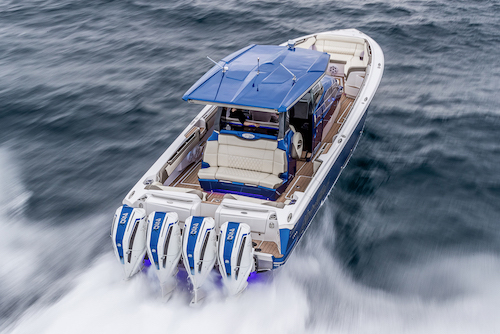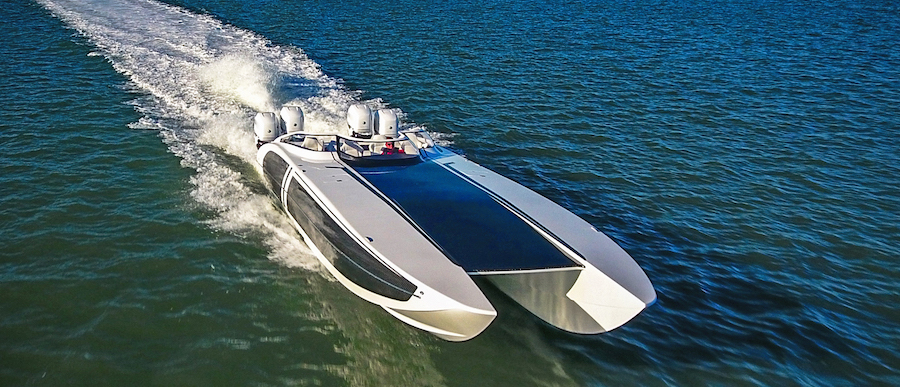When you think of boats that steal the show, go-fast boats are in a league of their own. These sleek, powerful machines are all about the thrill of speed and the joy of being on the water!
Go-fast boats are designed for the pure excitement of the ride, the rush of hitting top speeds, and the fun of turning heads as you cruise by. If you love cutting through the water with the wind in your hair and a smile on your face, then go-fast boats are the perfect choice.

Learn More about High Performance Boats
How Fast Can A Boat Go?
Boat speeds can vary significantly depending on the type of boat, engine power, and design.
Small sailboats typically reach max speeds of 5-10 knots (6-12 mph), while top-of-the-line go-fast boats push beyond 120 knots (138 mph)
How Fast Do Speed Boats Go?
Speed boats are designed for performance, offering a blend of power and agility that allows them to slice through the water at impressive speeds. Most recreational speed boats can reach speeds between 60 and 100 knots (69-115 mph).
How Fast Can A Pontoon Boat Go?
While they are not typically associated with high speeds, modern pontoon boats have come a long way in terms of performance. Depending on the size and engine, a pontoon boat can reach 15-30 knots (17-34 mph).
Some high-performance models, designed with more powerful engines and optimized hulls, can even push closer to 40 knots (46 mph), allowing for faster travel and a more dynamic boating experience.
Different Types of Go-Fast Boats
Go-fast boats, known for their high speed and sleek designs, come in various types, each with unique characteristics and intended use. Here's an overview of the most common types:
Cigarette Boats
Perhaps the most iconic go-fast boats, cigarette boats are long and narrow, designed for maximum speed on the water. They are often used in offshore powerboat racing and are known for their streamlined design.
These boats can easily reach speeds over 100 knots (115 mph) and are built to handle rough offshore conditions with agility and precision.
Catamarans
Catamarans are characterized by their twin-hull design, providing high-speed stability. These boats are popular in both racing and recreational boating for their smooth ride and ability to maintain high speeds even in choppy waters.
High-performance catamarans can achieve speeds exceeding 100 knots (115 mph), with their design allowing for sharp turns and agile handling.

V-Bottom Boats
Also known as deep-V hull boats, these versatile high-performance boats offer a good balance between speed, stability, and handling. Their hull design allows them to cut through waves efficiently, making them suitable for various water conditions.
V-bottom boats can reach speeds upwards of 90 knots (103 mph) and are often used for racing and recreational purposes.
Center Console Boats
While traditionally associated with fishing, some center console boats are designed with high-performance capabilities. These boats offer the speed of a go-fast boat with the added functionality of a center console, making them ideal for both racing and sport fishing.
High-performance center console boats can achieve 60-80 knots (69-92 mph), depending on their engine setup and design.
Offshore Powerboats
Built specifically for offshore racing, these boats are designed to endure the rigors of open-water conditions at high speeds. They typically feature reinforced hulls and robust engines, making them the go-to choice for competitive racing.
Offshore powerboats can exceed 100 knots (115 mph) and are known for their durability and performance in challenging conditions.
Each type of go-fast boat is designed with specific performance characteristics in mind, allowing enthusiasts to choose the boat that best suits their needs: prioritizing competitive racing, high-speed cruising, or a combination of both.
How Much Does a Go-Fast Boat Cost?
The cost of a go-fast boat varies widely based on brand, size, engine power, and customization options. Here's a general breakdown of what you can expect to pay:
- Entry-Level Go-Fast Boats: These smaller, less powerful models range from $50,000 to $100,000. They offer decent speed and performance, making them a good choice for beginners.
- Mid-Range Go-Fast Boats: With more powerful engines and better features, these boats typically cost between $100,000 and $300,000. They provide a good balance of speed, handling, and luxury.
- High-End Go-Fast Boats: These top-tier boats, often used in offshore racing, can cost anywhere from $300,000 to $1 million or more. They have the most powerful engines, advanced technology, and luxurious amenities.
- Custom and Ultra-Luxury Go-Fast Boats: For those seeking the ultimate in speed and luxury, custom-built go-fast boats can exceed $1 million, with some reaching $2 million or more. These boats are tailored to specific preferences, with high-end materials, cutting-edge technology, and robust engines.
Additional costs of boat ownership include maintenance, storage, insurance, and fuel, which should be factored into your overall budget when considering the purchase of any boat.
How Do I Get Involved In High-Performance Boating?
High-performance boating requires passion, knowledge, and the right equipment. Start by learning about the different types of high-performance boats.
Understanding the characteristics and capabilities of these vessels will help you decide which type suits your interests.
Enroll in boating safety courses and consider advanced training specifically focused on high-speed boating. Many organizations offer certifications that cover everything from basic operations to advanced handling techniques at high speeds.
Visit boat shows that feature high-performance vessels. These events are a great way to see the latest models, meet industry professionals, and get a feel for the community.
Connect with the community in person and online by joining local boating clubs or associations that focus on high-performance boating and getting active in online forums and social media groups for first-hand knowledge.
How Do I Learn To Drive (And Safely Handle) A Go-Fast Boat?
Driving a go-fast boat is an exhilarating experience, but it requires specific skills and knowledge to stay safe on the water.
1. Take a Boating Safety Course
Enroll in a boating safety course that covers the fundamentals of operating a boat, including navigation, rules of the water, and safety protocols.
After mastering the basics, take an advanced course focused on high-performance boating. These courses often cover handling high speeds, sharp turns, and rough water conditions.
2. Learn from Experienced Boaters
Spend time with experienced go-fast boat operators. Hands-on training with someone who knows the ins and outs of high-speed boating is invaluable. Consider finding a mentor who can provide guidance and tips as you learn.
3. Practice in Controlled Environments
Begin your practice in calm, open waters where you can focus on learning how your boat responds to different inputs without the pressure of navigating busy waterways.
Gradually increase your speed as you become more comfortable. Focus on mastering throttle control, steering, and handling at lower speeds before pushing the boat to its limits.
4. Understand Your Boat's Capabilities
Familiarize yourself with your boat's specific controls, features, and limitations. Understand how it behaves under different conditions, such as varying loads and weather. Regularly maintain your boat to ensure it performs reliably and safely. This includes checking the engine, steering system, and safety equipment.
5. Practice Safe Boating Habits
High-speed boating carries increased risks, so always wear a life jacket rated for high speeds.
Be aware of the weather and water conditions before heading out. High-performance boats can be incredibly challenging to handle in rough waters.
6. Get Comfortable with High-Speed Maneuvers
Learn how to safely execute high-speed turns, emergency stops, and other maneuvers. This will help you handle unexpected situations on the water. Don't rush into high-speed driving. Gradually build your confidence and skill level, always prioritizing safety.
By taking a structured approach to learning, practicing regularly, and respecting the power of a go-fast boat, you can enjoy the thrills of high-speed boating while staying safe on the water.

